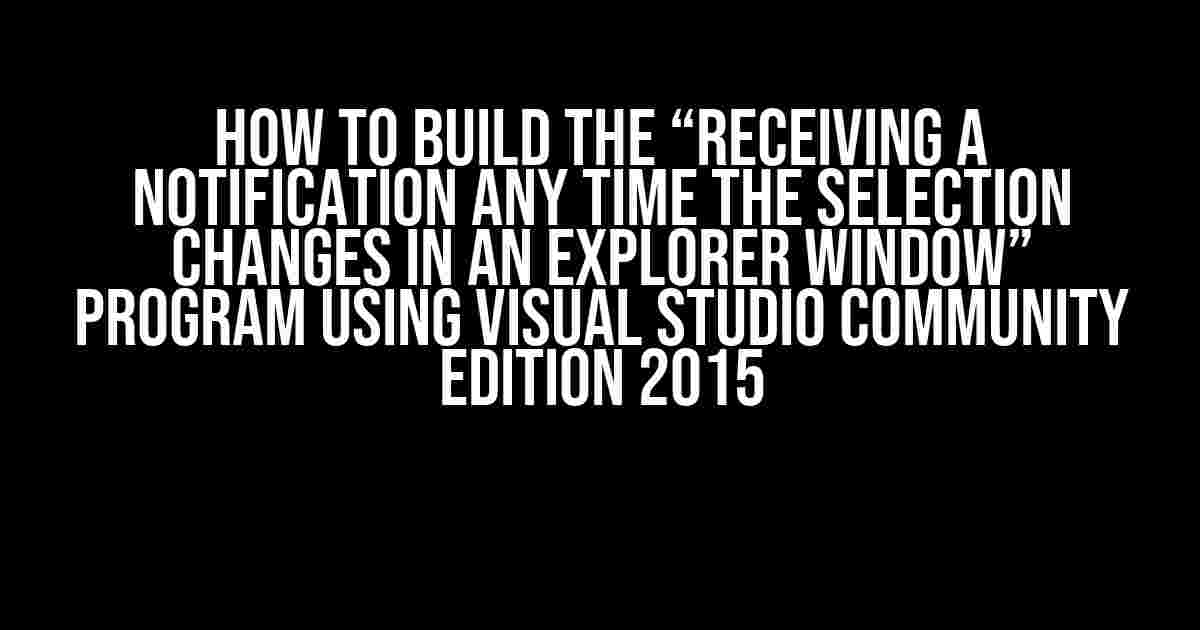If you’re tired of manually checking for changes in your Explorer window, this article is for you. We’ll take you through the step-by-step process of building a program that receives a notification any time the selection changes in an Explorer window using Visual Studio Community Edition 2015. Buckle up and get ready to learn!
Requirements and Pre-requisites
Before we dive into the coding part, make sure you have the following requirements and pre-requisites met:
- Visual Studio Community Edition 2015 installed on your system
- Basic understanding of C# programming language
- Familiarity with Windows API and Explorer interfaces
Creating a New Project in Visual Studio
To start, open Visual Studio Community Edition 2015 and create a new project:
- Click on “File” > “New” > “Project…” to open the “New Project” dialog box
- In the “Installed” > “Templates” > “Visual C#” section, select “Windows Forms App (.NET Framework)” and name your project (e.g., “ExplorerSelectionNotifier”)
- Click “OK” to create the project
Adding Required References and Libraries
To interact with the Explorer window, we need to add the required references and libraries to our project:
- In the Solution Explorer, right-click on the project and select “Add” > “Reference…”
- In the “Reference Manager” dialog box, navigate to “Assemblies” > “Framework” and check the box next to “System.Windows.Forms”
- Also, add a reference to “Microsoft Shell Controls and Automation” (Interop.Shell32.dll) by browsing to “C:\Windows\System32” and selecting the DLL file
- Click “OK” to add the references
Writing the Code
Now, let’s write the code to receive notifications when the selection changes in an Explorer window:
using System;
using System.Windows.Forms;
using Shell32;
namespace ExplorerSelectionNotifier
{
public partial class Form1 : Form
{
private Shell _shell;
private Folder _folder;
public Form1()
{
InitializeComponent();
}
private void Form1_Load(object sender, EventArgs e)
{
// Initialize the Shell object
_shell = new Shell();
// Get the current Explorer window
_folder = _shell.BrowseForFolder(0, "Select a folder", 0, 0);
// Register for the selection change notification
_folder.WindowsEvents.ItemChanged += WindowsEvents_ItemChanged;
}
private void WindowsEvents_ItemChanged(string strItem)
{
// Get the selected item
FolderItem folderItem = _folder.ParseName(strItem);
// Display a notification
MessageBox.Show("Selection changed to: " + folderItem.Name);
}
}
}
Explanation of the Code
The above code uses the Shell32 library to interact with the Explorer window. We create a Shell object and use it to get the current Explorer window (Folder object). We then register for the ItemChanged event on the Folder object, which fires whenever the selection changes.
In the WindowsEvents_ItemChanged event handler, we get the selected item using the ParseName method and display a notification using a MessageBox.
Testing the Program
To test the program, simply run the application and select a folder in the Explorer window:
- Press F5 to run the application
- Select a folder in the Explorer window
- Change the selection by clicking on a different item
- Observe the notification message box displaying the new selection
Troubleshooting and Optimization
If you encounter any issues or errors while running the program, try the following:
- Verify that you have the correct references and libraries added to your project
- Check for any typos or syntax errors in the code
- Ensure that the Explorer window is in focus and not minimized
To optimize the program, you can consider the following:
- Use a more efficient way of displaying notifications, such as using a Toast notification or a Taskbar notification
- Implement error handling and exception handling to make the program more robust
- Consider using a more modern API or library to interact with the Explorer window
Conclusion
And that’s it! You have successfully built a program that receives a notification any time the selection changes in an Explorer window using Visual Studio Community Edition 2015.
This program demonstrates the power of using Windows API and Explorer interfaces to interact with the Explorer window. With this knowledge, you can create more complex and useful applications that integrate with the Explorer window.
| Keyword | Description |
|---|---|
| Explorer window | The main window of the Windows Explorer application |
| Selection change | An event that occurs when the user selects a different item in the Explorer window |
| Notification | A message or alert displayed to the user when an event occurs |
| Visual Studio Community Edition 2015 | A free, feature-rich IDE for building Windows applications |
We hope you found this article informative and helpful. Happy coding!
Frequently Asked Question
Get ready to build an amazing program that receives notifications whenever the selection changes in an Explorer window using Visual Studio Community Edition 2015!
What programming language should I use to build this program?
You can use C# or VB.NET to build this program. Both languages are fully supported by Visual Studio Community Edition 2015 and can be used to create a Windows Explorer shell extension.
What kind of project should I create in Visual Studio to build this program?
You should create a new “Class Library” project in Visual Studio Community Edition 2015. This will allow you to create a DLL that can be used as a Windows Explorer shell extension.
How do I implement the notification feature in my program?
You can implement the notification feature by using the `IOleCommandTarget` interface and handling the `SelectionChanged` event. This event is fired whenever the selection changes in an Explorer window.
How do I register my program as a Windows Explorer shell extension?
You can register your program as a Windows Explorer shell extension by adding the necessary registry keys and values. This can be done using the `RegAsm` tool or by using a setup project in Visual Studio.
How do I test my program to ensure it’s working correctly?
You can test your program by opening an Explorer window, selecting a file or folder, and verifying that your program receives the notification. You can also use debugging tools like Visual Studio’s debugger to step through your code and ensure it’s working as expected.
